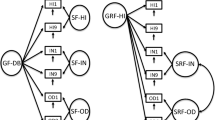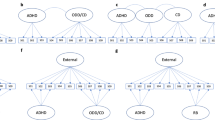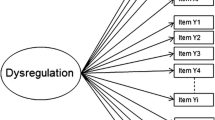Abstract
The current study investigated the clinical utility and validity of a bifactor model for representing ADHD symptoms in young adults. Two-hundred and seventy-eight participants (33.8% male) aged 18–24 and informants completed well-validated measures of ADHD symptoms and internalizing and externalizing behaviors. Results across self- and informant-report methods suggested a bifactor model with inattentive and hyperactive/impulsive specific factors as the best fitting conceptualization of ADHD symptoms. Within this bifactor model, the general (“g”) factor was found to be an interpretable representation of most ADHD symptoms that demonstrated significant associations with several internalizing and externalizing behaviors. Over and above “g,” inattentive and hyperactive/impulsive specific factors appeared to account for unique information in ADHD symptoms, particularly those corresponding with difficulties following through on instructions and verbal impulsivity, respectively. Specific factors also appeared to account for unique information pertaining to anxious/depressed and intrusive behavioral dysfunction, over and above either “g” or total ADHD symptom count scores. Overall, results suggested that integration of different components of the bifactor model, particularly HI, into clinical practice may help parse heterogeneity in ADHD-related phenotypes during young adulthood.

Similar content being viewed by others
References
Achenbach, T. M., & Rescorla, L. A. (2003). Manual for the ASEBA Adult Forms & Profiles. Burlington: University of Vermont, Research Center for Children, Youth, & Families.
American Psychiatric Association. (2013). Diagnostic and statistical manual of mental disorders (5th ed.). DC: Washington.
Arias, V. B., Ponce, F. P., & Núñez, D. E. (2016). Bifactor models of attention-deficit/hyperactivity disorder (ADHD): An evaluation of three necessary but underused psychometric indexes. Assessment, 25, 885–897. https://doi.org/10.1177/1073191116679260.
Arnett, J. J. (2000). Emerging adulthood: A theory of development from the late teens through the twenties. American Psychologist, 55, 469–480. https://doi.org/10.1037/0003-066X.55.5.469.
Barkley, R. A. (2011). The Barkley adult ADHD rating scale - IV. New York: Guilford Press.
Belsley, D. A. (1984). Demeaning conditioning diagnostics through centering. The American Statistician, 38, 73–93.
Belsley, D. A., Kuh, E., & Welsch, R. E. (1980). Regression diagnostics: Identifying influential data and sources of collinearity. New York: Wiley.
Bonifay, W., & Cai, L. (2017). On the complexity of item response theory models. Multivariate Behavioral Research, 52, 465–484. https://doi.org/10.1080/00273171.2017.1309262.
Bonifay, W., Lane, S. P., & Reise, S. P. (2017). Three concerns with applying a bifactor model as a structure of psychopathology. Clinical Psychological Science, 5, 184–186. https://doi.org/10.1177/2167702616657069.
Burnham, K. P., & Anderson, D. R. (2004). Multimodel inference: Understanding AIC and BIC in model selection. Sociological Methods & Research, 33, 261–304. https://doi.org/10.1177/0049124104268644.
Burns, G. L., de Moura, M. A., Beauchaine, T. P., & McBurnett, K. (2014). Bifactor latent structure of ADHD/ODD symptoms: Predictions of dual-pathway/trait-impulsivity etiological models of ADHD. Journal of Child Psychology and Psychiatry, 55, 393–401.
Du Rietz, E., Cheung, C. H., McLoughlin, G., Brandeis, D., Banaschewski, T., Asherson, P., & Kuntsi, J. (2016). Self-report of ADHD shows limited agreement with objective markers of persistence and remittance. Journal of Psychiatric Research, 82, 91–99. https://doi.org/10.1016/j.jpsychires.2016.07.020.
DuPaul, G. J., Reid, R., Anastopoulos, A. D., Lambert, M. C., Watkins, M. W., & Power, T. J. (2016). Parent and teacher ratings of attention-deficit/hyperactivity disorder symptoms: Factor structure and normative data. Psychological Assessment, 28, 214–225. https://doi.org/10.1037/pas0000166.
Flora, D. B., & Curran, P. J. (2004). An empirical evaluation of alternative methods of estimation for confirmatory factor analysis with ordinal data. Psychological Methods, 9, 466–491. https://doi.org/10.1037/1082-989X.9.4.466.
Garnefski, N., Kraaij, V., & van Etten, M. (2005). Specificity of relations between adolescents’ cognitive emotion regulation strategies and internalizing and externalizing psychopathology. Journal of Adolescence, 28, 619–631. https://doi.org/10.1016/j.adolescence.2004.12.009.
Gibbins, C., Toplak, M. E., Flora, D. B., Weiss, M. D., & Tannock, R. (2012). Evidence for a general factor model of ADHD in adults. Journal of Attention Disorders, 16, 635–644. https://doi.org/10.1177/1087054711416310.
Gomez, R., Vance, A., & Gomez, R. M. (2018). Validity of the ADHD bifactor model in general community samples of adolescents and adults, and a clinic-referred sample of children and adolescents. Journal of Attention Disorders, 22, 1307-1319. https://doi.org/10.1177/1087054713480034
Green, A. L., & Rabiner, D. L. (2012). What do we really know about ADHD in college students? Neurotherapeutics, 9, 559–568. https://doi.org/10.1007/s13311-012-0127-8.
Haslam, N., Williams, B., Prior, M., Haslam, R., Graetz, B., & Sawyer, M. (2006). The latent structure of attention-deficit/hyperactivity disorder: A taxometric analysis. Australian and New Zealand Journal of Psychiatry, 40, 639–647. https://doi.org/10.1080/j.1440-1614.2006.01863.x.
Heiligenstein, E., & Keeling, R. P. (1995). Presentation of unrecognized attention deficit hyperactivity disorder in college students. Journal of American College Health, 43, 226–228. https://doi.org/10.1080/07448481.1995.9940481.
Hu, L. T., & Bentler, P. M. (1999). Cutoff criteria for fit indexes in covariance structure analysis: Conventional criteria versus new alternatives. Structural Equation Modeling: A Multidisciplinary Journal, 6, 1–55.
Jensen, A. R. (1998). The g factor: The science of mental ability (Vol. 648). Westport: Praeger.
Jensen, P. S., Hinshaw, S. P., Kraemer, H. C., Lenora, N., Newcorn, J. H., Abikoff, H. B., et al. (2001). ADHD comorbidity findings from the MTA study: Comparing comorbid subgroups. Journal of the American Academy of Child & Adolescent Psychiatry, 40, 147–158.
Kass, R. E., & Raftery, A. E. (1995). Bayes factors. Journal of the American Statistical Association, 90, 773–795.
Lahey, B. B., & Carlson, C. L. (1991). Validity of the diagnostic category of attention deficit disorder without hyperactivity: A review of the literature. Journal of Learning Disabilities, 24, 110–120. https://doi.org/10.1177/002221949102400208.
Lahey, B. B., & Willcutt, E. G. (2010). Predictive validity of a continuous alternative to nominal subtypes of attention-deficit/hyperactivity disorder for DSM-V. Journal of Clinical Child and Adolescent Psychology, 39, 761–775. https://doi.org/10.1080/15374416.2010.517173.
Li, J. J., Reise, S. P., Chronis-Tuscano, A., Mikami, A. Y., & Lee, S. S. (2016). Item response theory analysis of ADHD symptoms in children with and without ADHD. Assessment, 23, 655–671. https://doi.org/10.1177/1073191115591595.
Marcus, D. K., & Barry, T. D. (2011). Does attention-deficit/hyperactivity disorder have a dimensional latent structure? A taxometric analysis. Journal of Abnormal Psychology, 120, 427–442. https://doi.org/10.1037/a0021405.
Martel, M. M., & Nigg, J. T. (2006). Child ADHD and personality/temperament traits of reactive and effortful control, resiliency, and emotionality. The Journal of Child Psychology and Psychiatry, 47, 1175–1183. https://doi.org/10.1111/j.1469-7610.2006.01629.x.
Martel, M. M., von Eye, A., & Nigg, J. T. (2010). Revisiting the latent structure of ADHD: Is there a 'g' factor? Journal of Child Psychology and Psychiatry, 51, 905–914. https://doi.org/10.1111/j.1469-7610.2010.02232.x.
Martel, M. M., Roberts, B., Gremillion, M., von Eye, A., & Nigg, J. T. (2011). External validation of bifactor model of ADHD: Explaining heterogeneity in psychiatric comorbidity, cognitive control, and personality trait profiles within DSM-IV ADHD. Journal of Abnormal Child Psychology, 39, 1111–1123. https://doi.org/10.1007/s10802-011-9538-y.
Martel, M. M., von Eye, A., & Nigg, J. (2012). Developmental differences in structure of attention-deficit/hyperactivity disorder (ADHD) between childhood and adulthood. International Journal of Behavioral Development, 36, 279–292. https://doi.org/10.1177/0165025412444077.
McLennan, J. D. (2016). Understanding attention deficit hyperactivity disorder as a continuum. Canadian family physician Medecin de famille canadien, 62, 979–982.
Meehan, K. B., De Panfilis, C., Cain, N. M., & Clarkin, J. F. (2013). Effortful control and externalizing behaviors in young adults. Personality and Individual Differences, 55, 553–558.
Muthén, L. K., & Muthén, B. O. (1998-2012). Mplus version 7 user’s guide. Los Angeles: Muthén & Muthén.
Nigg, J. T., Goldsmith, H. H., & Sachek, J. (2004). Temperament and attention deficit hyperactivity disorder: The development of a multiple pathway model. Journal of Clinical Child and Adolescent Psychology, 33, 42–53.
Nussbaum, N. L. (2012). ADHD and female-specific concerns: A review of the literature and clinical implications. Journal of Attention Disorders, 16, 87–100. https://doi.org/10.1177/1087054711416909.
O’Brien, R. M. (2007). A caution regarding rules of thumb for variance inflation factors. Quality & Quantity, 41, 673–690.
Olson, S. L. (2002). Developmental perspectives. In S. Sandberg (Ed.), Hyperactivity and attention disorders of childhood (2 ed., pp. 242–289). England: Cambridge University Press.
Quinn, P. O., & Madhoo, M. (2014). A review of attention-deficit/hyperactivity disorder in women and girls: Uncovering this hidden diagnosis. The Primary Care Companion for CNS Disorders, 16(3), PCC.13r01596. https://doi.org/10.4088/PCC.13r01596.
Reise, S. P., Moore, T. M., & Haviland, M. G. (2010). Bifactor models and rotations: Exploring the extent to which multidimensional data yield univocal scale scores. Journal of Personality Assessment, 92, 544–559. https://doi.org/10.1080/00223891.2010.496477.
Reise, S. P., Moore, T. M., & Haviland, M. G. (2013a). Applying unidimensional item response theory models to psychological data. In K. F. Geisinger, B. A. Bracken, J. F. Carlson, J.-I. C. Hansen, N. R. Kuncel, S. P. Reise, & M. C. Rodriguez (Eds.), APA handbooks in psychology. APA handbook of testing and assessment in psychology, Vol. 1. Test theory and testing and assessment in industrial and organizational psychology (pp. 101–119). Washington, DC: American Psychological Association.
Reise, S. P., Scheines, R., Widaman, K. F., & Haviland, M. G. (2013b). Multidimensionality and structural coefficient bias in structural equation modeling: A bifactor perspective. Educational and Psychological Measurement, 73, 5–26. https://doi.org/10.1177/0013164412449831.
Rodriguez, A., Reise, S. P., & Haviland, M. G. (2016). Applying bifactor statistical indices in the evaluation of psychological measures. Journal of Personality Assessment, 98, 223–237. https://doi.org/10.1080/00223891.2015.1089249.
Satorra, A., & Bentler, P. M. (2010). Ensuring positiveness of the scaled difference chi-square test statistic. Psychometrika, 75, 243–248. https://doi.org/10.1007/s11336-009-9135-y.
Schatz, D. B., & Rostain, A. L. (2006). ADHD with comorbid anxiety: A review of the current literature. Journal of Attention Disorders, 10, 141–149. https://doi.org/10.1177/1087054706286698.
Skogli, E. W., Teicher, M. H., Andersen, P. N., Hovik, K. T., & Øie, M. (2013). ADHD in girls and boys–gender differences in co-existing symptoms and executive function measures. BMC Psychiatry, 13, 298.
Sonuga-Barke, E. J. (2005). Causal models of attention-deficit/hyperactivity disorder: From common simple deficits to multiple developmental pathways. Biological Psychiatry, 57, 1231–1238. https://doi.org/10.1016/j.biopsych.2004.09.008.
Sorge, G. B., Flora, D. B., van der Maas, M., Vingilis, E., Erickson, P., Kolla, N. J., Mann, R. E., Seeley, J., & Toplak, M. E. (2015). Using factor analytic models to examine the association between attention-deficit/hyperactivity disorder symptoms and health-related outcomes in a representative population survey. ADHD Attention Deficit and Hyperactivity Disorders, 7, 225–235. https://doi.org/10.1007/s12402-015-0167-0.
Stucky, B. D., & Edelen, M. O. (2014). Using hierarchical IRT models to create unidimensional measures from multidimensional data. In S. P. Reise & D. A. Revicki (Eds.), Handbook of item response theory modeling: Applications to typical performance assessment (pp. 183–206). New York: Routledge/Taylor & Francis Group.
Toplak, M. E., Pitch, A., Flora, D. B., Iwenofu, L., Ghelani, K., Jain, U., & Tannock, R. (2009). The unity and diversity of inattention and hyperactivity/impulsivity in ADHD: Evidence for a general factor with separable dimensions. Journal of Abnormal Child Psychology, 37, 1137–1150. https://doi.org/10.1007/s10802-009-9336-y.
Wagner, F., Martel, M. M., Cogo-Moreira, H., Maia, C. R., Pan, P. M., Rohde, L. A., & Salum, G. A. (2016). Attention-deficit/hyperactivity disorder dimensionality: The reliable 'g' and the elusive 's' dimensions. European Child and Adolescent Psychiatry, 25, 83–90. https://doi.org/10.1007/s00787-015-0709-1.
Wehmeier, P. M., Schacht, A., & Barkley, R. A. (2010). Social and emotional impairment in children and adolescents with ADHD and the impact on quality of life. Journal of Adolescent Health, 46, 209–2017. https://doi.org/10.1016/j.jadohealth.2009.09.009.
Weston, R., & Gore Jr., P. A. (2006). A brief guide to structural equation modeling. The Counseling Psychologist, 34, 719–751. https://doi.org/10.1177/0011000006286345.
Wilens, T. E., Biederman, J., Faraone, S. V., Martelon, M., Westerberg, D., & Spencer, T. J. (2009). Presenting ADHD symptoms, subtypes, and comorbid disorders in clinically referred adults with ADHD. The Journal of Clinical Psychiatry, 70, 1557–1562. https://doi.org/10.4088/JCP.08m04785pur.
Willcutt, E. G., Nigg, J. T., Pennington, B. F., Solanto, M. V., Rohde, L. A., Tannock, R., Loo, S. K., Carlson, C. L., McBurnett, K., & Lahey, B. B. (2012). Validity of DSM-IV attention deficit/hyperactivity disorder symptom dimensions and subtypes. Journal of Abnormal Psychology, 121, 991–1010. https://doi.org/10.1037/a0027347.
Willoughby, M. T., Pek, J., Greenberg, M. T., & Family Life Project, I. (2012). Parent-reported attention deficit/hyperactivity symptomatology in preschool-aged children: Factor structure, developmental change, and early risk factors. Journal of Abnormal Child Psychology, 40, 1301–1312. https://doi.org/10.1007/s10802-012-9641-8.
Willoughby, M. T., Blanton, Z. E., & Family Life Project, I. (2015). Replication and external validation of a bi-factor parameterization of attention deficit/hyperactivity symptomatology. Journal of Clinical Child and Adolescent Psychology, 44, 68–79. https://doi.org/10.1080/15374416.2013.850702.
Willoughby, M. T., Fabiano, G. A., Schatz, N. K., Vujnovic, R. K., & Morris, K. L. (2017). Bifactor models of attention deficit/hyperactivity symptomatology in adolescents: Criterion validity and implications for clinical practice. Assessment. Advance online publication. https://doi.org/10.1177/1073191117698755.
Funding
This project was supported by institutional start-up funds to Dr. Michelle Martel from the University of Kentucky. The authors thank all participants for making this work possible.
Author information
Authors and Affiliations
Corresponding author
Ethics declarations
Conflict of Interest
Patrick Goh, Christine Lee, Pevitr Bansal, Luis Aguerrevere, Abby Rucker, and Michelle Martel declare that they have no conflicts of interest.
Experiment Participants
All procedures performed in studies involving human participants were in accordance with the ethical standards of the institutional and/or national research committee (Office of Research Integrity Institutional Review Board; Protocol #12–0881-F4S) and with the 1864 Helsinki declaration and its later amendments or comparable ethical standards.
Informed Consent
Informed consent was obtained from all individual participants included in the study.
Additional information
Publisher’s Note
Springer Nature remains neutral with regard to jurisdictional claims in published maps and institutional affiliations.
Rights and permissions
About this article
Cite this article
Goh, P.K., Lee, C.A., Bansal, P.S. et al. Interpretability and Validity of a Bifactor Model of ADHD in Young Adults: Assessing the General “g” and Specific IA and HI Factors. J Psychopathol Behav Assess 42, 222–236 (2020). https://doi.org/10.1007/s10862-019-09774-7
Published:
Issue Date:
DOI: https://doi.org/10.1007/s10862-019-09774-7




